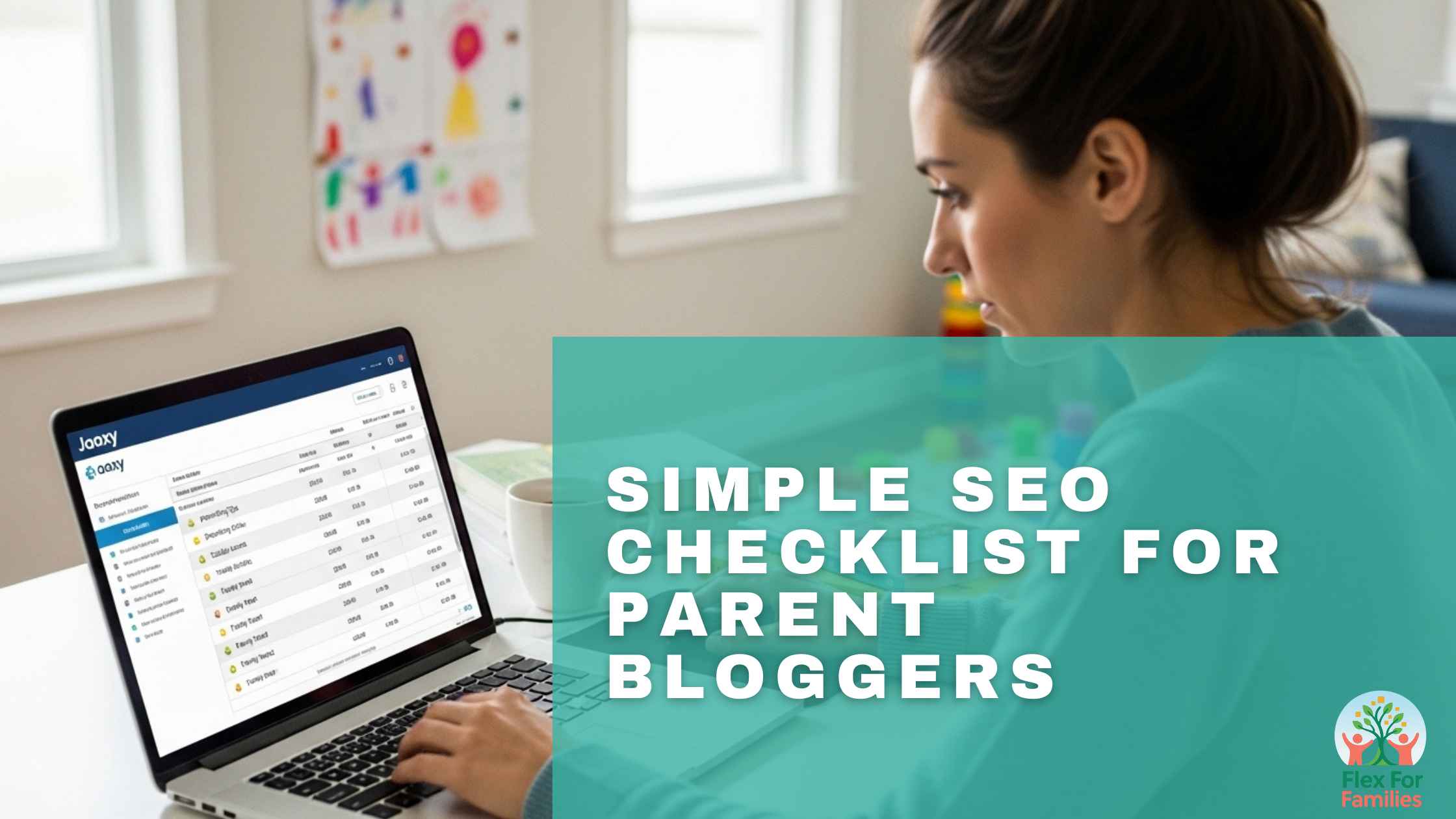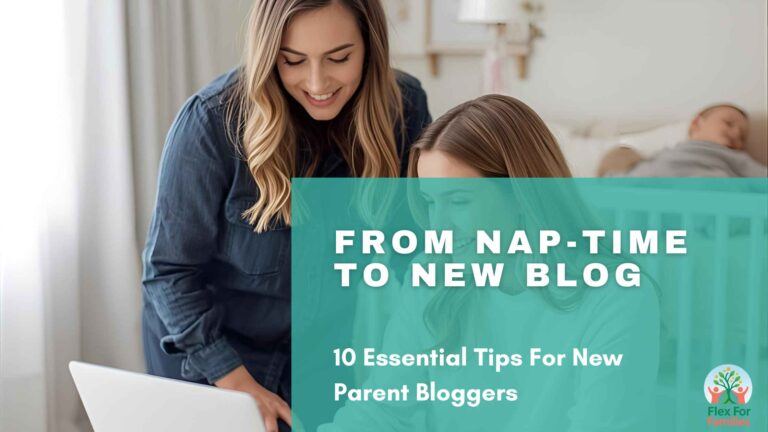If you’ve ever googled “SEO tips” and felt your eyes glaze over before the first paragraph, you’re definitely not alone. Between keyword tools, meta tags, and ranking algorithms, it can sound like a foreign language.
But here’s the good news: SEO doesn’t have to be complicated or technical. At its core, it’s simply about helping the right people find your blog through search engines.
And for parent bloggers, that matters more than ever. Every blog post you write has the potential to reach another parent looking for advice, support, or inspiration. Learning a few simple SEO steps can help your voice travel further without needing to post nonstop on social media.
This checklist breaks SEO down into small, practical actions you can do in short bursts. During nap time, school hours, or those rare quiet evenings.
If you’re just starting your blog and want a head start on what to focus on first, grab my free Nap-Time Blogging Checklist. It pairs perfectly with this guide and walks you through setting up your blog step-by-step.
What Is SEO (and Why It Matters for Parent Bloggers)
Let’s keep it real. SEO can sound like something only tech experts talk about, but it’s actually one of the simplest ways to help your blog grow quietly in the background.
SEO stands for Search Engine Optimisation. In plain English, it means making your blog easy for Google to understand so it can share your posts with the right readers.

Think of it like organising your kids’ toy bins. When everything has a clear label, it’s faster to find what you’re looking for. SEO works the same way for your blog. The clearer and more relevant your content is, the easier it is for search engines to “find” and show it to parents searching for answers.
For parent bloggers, SEO isn’t just about traffic numbers. It’s about connection. It’s what helps a mom searching “how to start a parenting blog” find your story. Or a dad looking for “meal ideas for picky toddlers” lands on your post.
Good SEO helps your blog reach the people who need your advice, experiences, and encouragement the most. And the best part? Once you set it up, it keeps working quietly while you focus on family life.
Parent Tip: You don’t need to be an expert to see results from SEO. Focus on helping your readers, use simple keywords, and consistency will do the rest.
Simple SEO Checklist for Parent Bloggers
SEO doesn’t have to be complicated. The secret is to take small, consistent steps that build over time.

Here’s a parent-friendly checklist you can follow before, during, and after publishing each blog post.
Before You Write
1. Choose one main keyword.
Think about what your readers might type into Google. For example, instead of “SEO tips,” they might search “simple SEO for parent bloggers.” Use tools like Jaaxy or Ubersuggest to find phrases with good search volume but low competition.
2. Understand the search intent.
Ask yourself what your reader wants when they search that phrase. Are they looking to learn, compare, or buy something? Match your content to their goal.
3. Plan your post structure.
Write a quick outline with clear headings and sections. Google loves well-organised content, and so do busy readers who scan posts for key takeaways.
While You Write
4. Use your main keyword naturally.
Include it in your title, first paragraph, and one subheading. After that, let it appear naturally — don’t force it.
5. Write like you’re talking to a friend.
Search engines now prioritise helpful content. Focus on clarity, warmth, and answering real questions.
6. Add related phrases.
If your keyword is “blogging tips for moms,” you could include phrases like “starting a blog,” “parent blog ideas,” or “make money from home.” These help Google understand your topic better.
7. Break up long paragraphs.
Short paragraphs, lists, and bolded key points make your post easier to read and improve your SEO.
After You Publish
8. Add your meta title and description.
These appear in Google’s search results, so make them clear and inviting. Tools like Rank Math or Yoast can help you write them quickly.
9. Optimise your images.
Rename your image files to match your topic and add alt text (short image descriptions). Use TinyPNG to compress large images before uploading.
10. Link to other posts.
Add links to 2–3 related posts on your blog. It helps readers explore more of your content and signals to Google that your site is helpful.
11. Share your post.
Promote it on Pinterest, Facebook, or in your email list. Early traffic helps search engines notice your post faster.
Parent Tip: Treat SEO like tidying your digital space. A few small tweaks each week can make a big difference over time, without adding stress to your routine.
Common SEO Mistakes to Avoid

Even with the best intentions, it’s easy to make a few SEO slip-ups, especially when you’re juggling blogging with parenting. The good news is that most of these mistakes are simple to fix once you know what to look for.
1. Keyword Stuffing
Repeating the same keyword over and over doesn’t help your SEO — it actually hurts it. Write naturally, as if you’re explaining something to a friend. Google now values helpful, human writing over repetition.
2. Ignoring Readability
Huge blocks of text can turn readers away, no matter how valuable the content is. Break up your writing with short paragraphs, headers, and bullet points so busy parents can scan quickly.
3. Skipping Image Optimisation
Forgetting to add alt text or compressing your images slows down your site and makes it harder for search engines to understand what’s on your page. Adding short, descriptive image text helps both SEO and accessibility.
4. Forgetting Internal Links
Each post should connect to a few others on your blog. Internal links help readers find related content and tell Google that your site covers topics in depth.
5. Neglecting Mobile Readers
Most parents scroll on their phones, not laptops. If your site loads slowly or the text looks cramped, Google may rank it lower. Use a responsive design and test your site on your phone often.
6. Giving Up Too Soon
This might be the biggest one. SEO takes time to build momentum. You might not see results for a few months, but your efforts will pay off with steady, lasting traffic.
Parent Tip: Don’t stress over getting everything perfect. SEO rewards consistency more than perfection. Keep learning, apply one tip at a time, and your blog will grow.
Helpful SEO Tools for Parent Bloggers

You don’t need complicated tools or expensive subscriptions to make your blog search-friendly. These simple, beginner-friendly options help you understand what people are looking for and how to get your posts seen.
1. Jaaxy (My Go-To Keyword Tool)
If you’ve ever sat staring at your screen thinking, “What should I write about next?” — Jaaxy is the answer.
It’s an intuitive keyword tool that helps you find phrases real people are searching for, along with how competitive each one is. The latest update inside Wealthy Affiliate makes it faster, smarter, and perfect for beginner bloggers who don’t want to overcomplicate SEO.
You can use Jaaxy to:
- Discover low-competition keywords ideal for new blogs
- Track how your blog posts rank over time
- Save keyword lists for future ideas
💡 Parent win: It saves hours of guesswork and helps you focus on topics that actually attract readers.
2. Ubersuggest
A great free option for finding related keywords and seeing how hard they are to rank for. It’s quick to use and gives you practical insights for your next post.
3. Rank Math or Yoast
Both are WordPress plugins that act like on-page SEO checklists. They guide you step-by-step through optimising your title, meta description, and readability before you hit publish.
4. Google Search Console
Completely free and invaluable. It shows what search terms your blog is already ranking for and helps you spot opportunities to improve your visibility.
5. TinyPNG
This tool compresses your images so your pages load faster. A speedy site keeps both your readers and Google happy.
6. AnswerThePublic
Type in a topic like “parenting hacks” or “affiliate marketing for moms,” and you’ll see a visual map of questions people are actually asking. It’s fantastic for brainstorming blog post ideas that your audience genuinely cares about.
Parent Tip: Start small. Choose one tool—like Jaaxy or Rank Math—and learn it well. A little consistency beats using every tool once and getting lost in data.
Frequently Asked Questions About SEO for Parent Bloggers
Even with a simple checklist, SEO can still raise a few questions. Here are some of the most common ones I hear from new parent bloggers.
Do I really need SEO if I promote my blog on social media?
Yes, because social media traffic is temporary. SEO creates long-term visibility. A single post that ranks well on Google can bring in visitors for months or even years without you having to share it repeatedly.
Think of social media as a spark and SEO as the slow-burning candle that keeps your traffic steady.
How long does it take for SEO to work?
SEO isn’t instant, but it’s worth it. Most new blogs start seeing small results after a few months, and steady growth within six to twelve months of consistent posting.
If you publish regularly and follow a simple SEO routine, you’ll see progress before you know it.
How many keywords should I use in one post?
Focus on one main keyword and a few natural variations. More isn’t better. Overloading your post with too many keywords can make it sound robotic and hurt your rankings.
Write for parents first, then fine-tune for search engines.
Do I need to pay for SEO tools?
Not at all. Free tools like Ubersuggest, Google Search Console, and TinyPNG are enough to start with. As you grow, premium tools like Jaaxy can save time and make your keyword research more precise — but you can succeed without paying for anything upfront.
Can SEO work for parenting or lifestyle blogs?
Absolutely. In fact, these niches do especially well because they answer everyday questions parents are already searching for.
Blog posts about family routines, organisation tips, recipes, or work-from-home ideas all have strong SEO potential.
Parent Tip: Every blog post you write is an opportunity for SEO. Don’t worry about mastering everything at once—each small improvement helps your future posts perform even better.
SEO Mindset: Progress, Not Perfection
When it comes to SEO, patience really is the secret ingredient. You don’t have to get everything perfect, and you definitely don’t need to understand every update Google makes.

What matters most is staying consistent. Every blog post you write, every keyword you research, and every image you optimise adds up. It’s like planting seeds — you might not see growth right away, but with time and care, your blog will start to bloom.
Think of SEO as a quiet partner in your blogging journey. It works behind the scenes while you focus on family, content, and building connections. The more you write with care and purpose, the more search engines recognise your value.
If you’re ready to learn how SEO fits into a bigger blogging strategy that includes earning income on your terms, this is where I started.
💬 Let’s Chat!
SEO doesn’t have to feel like a guessing game. Once you take the first few steps, you’ll see how manageable it really is.
I’d love to know — what part of SEO feels most confusing or intimidating to you right now? Drop your thoughts in the comments below. Your question might inspire the next guide to help other parent bloggers just like you.




